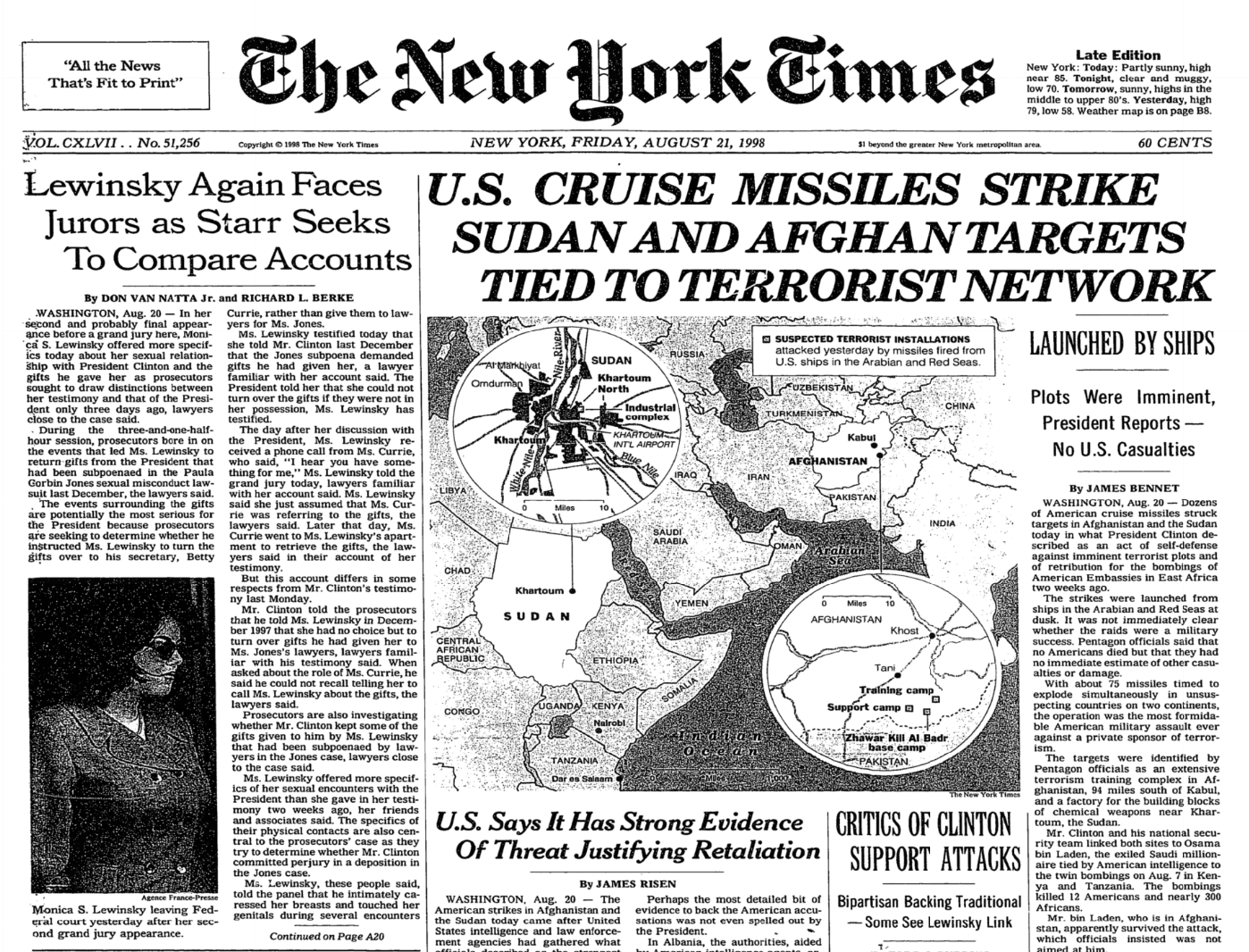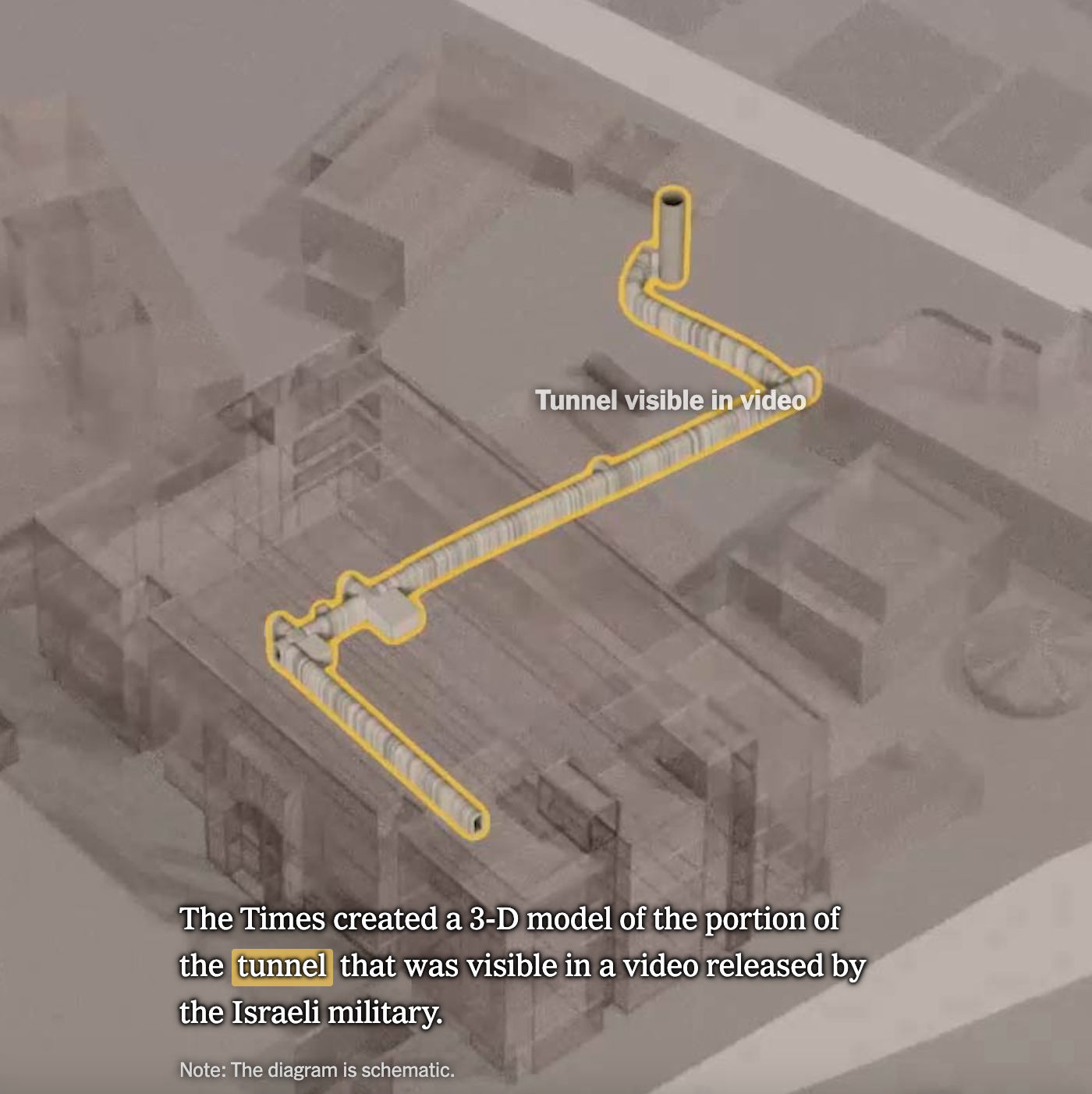On August 7, 1998, al-Qaeda launched deadly attacks on U.S. embassies in Kenya and Tanzania. The Clinton administration pledged to retaliate and zeroed in on the Al-Shifa pharmaceutical plant in Khartoum, Sudan, as its object of retribution. Without publicly releasing a shred of supporting evidence, American officials insisted, loudly and authoritatively, that Khartoum’s Al-Shifa was “associated with the bin Laden network” and instrumental in the “production of chemical weapons.” Less than two weeks after the embassy attacks, Clinton dispatched a dozen cruise missiles to obliterate the pharmaceutical complex. Al-Shifa was, in fact, a civilian facility that manufactured low-cost, critical medicine for the country. Such deception resulted in carnage. The U.S. was responsible for the deaths of “tens of thousands of people…[who] suffered and died from treatable diseases,” due to the demolition of the pharmaceutical plant.
The Clinton administration could not produce convincing evidence to back the story, and, according to journalist Richard Bernstein, American authorities had to eventually retreat from their claims because “no direct financial relationship between bin Laden and the plant could be established.”
The New York Times ought to have relayed testimony from people on the ground—that the facility was not used to produce chemical weapons—or, at the very least, questioned the veracity of the intelligence until it was backed by hard evidence. The Times, however, implicitly understood that questioning the U.S. empire, especially in a moment of vulnerability, was not its job. So, rather than investigate, they simply relayed dodgy intelligence estimates as fact.
The next-day front page headline, in all caps, read: “U.S. CRUISE MISSILES STRIKE SUDAN AND AFGHAN TARGETS TIED TO TERRORIST NETWORK.”

A second article on the front page legitimized U.S. intelligence again: “U.S. Says It Has Strong Evidence Of Threat Justifying Retaliation.”
A third buried the Sudanese government’s claim that Al-Shifa was civilian infrastructure beneath 20 paragraphs of state propaganda. The Editorial Board weighed in, too, writing in “Striking Against Terrorism,”
“The United States has every right to attack suspected terrorists if there is credible evidence showing that they were involved in attacks against American citizens or were planning such attacks. That seems to be the case in the missile attacks ordered by President Clinton in the Sudan and Afghanistan.”
Much of The Times’ reporting simply assumed the U.S. military position, parroted its intelligence, and failed to investigate the accuracy of evidence connecting the facility to the “bin Laden network.” In one piece for its international edition, “'Not Just Retaliation, but Also an Act of Self-Defense': U.S. Attacks Terror Sites in Afghanistan and Sudan,” The Times accepted the U.S. framing of the attacks as self-defense, and uncritically presented U.S. intelligence as fact: “Chemical weapons were under development at a plant in Sudan, which was one of the targets of the U.S. raid, [General Shelton] added.” The Times went on to stress, explicitly, that President Bill Clinton was left with “no option” but cruise missile attacks:
“Both the Sudanese government and the Taliban, which has been harboring Mr. bin Laden, have made it clear that they had no intention of cooperating with any U.S. attempt to bring to justice Islamic terrorists traced to their soil.
That left Washington with no option but to mount a military attack.”
When a criminal syndicate wants to “launder” its illegally acquired money, it filters and re-filters the money through a variety of legal enterprises until the money emerges “clean” and legitimate on the other side. To the U.S. intelligence apparatus, The New York Times and other mainstream, trusted news outlets perform a similar function. “Intelligence” is fed through the legitimizing apparatus of The Times, and on the other side emerges “reporting” that appears at least quasi-independent of the state.
This process was most famously employed by the Bush administration in the buildup to the Iraq War. Vice President Cheney, CIA Director George Tenet, and their acolytes were desperate to turn their shoddy, oftentimes wholly fraudulent intelligence—collected from Iraqi defectors, opportunist opposition leaders, and other dubious sources—into an ironclad case that Saddam Hussein was both harboring al-Qaeda, and secretly manufacturing weapons of mass destruction.
In September 2002, the U.S. government kicked its public relations campaign into high gear. “From a marketing point of view, you don't introduce new products in August,” quipped the White House Chief of Staff in a New York Times “quotation of the day.” Marketing is precisely what The Times did. The paper dutifully ran uncritical front page stories that validated the intelligence and, in turn, manufactured consent for the catastrophic American invasion of Iraq.
In one instance, the White House leaked evidence that Saddam Hussein was attempting to purchase aluminum tubes suitable for constructing a nuclear centrifuge. The Times ran the now discredited story “U.S. says Hussein intensifies quest for A-Bomb parts.” That same week, three of the highest-ranking U.S. officials—Vice President Dick Cheney, Defense Secretary Donald Rumsfeld, and National Security Advisor Condoleezza Rice—appeared on separate morning talk shows to promote this new evidence. Cheney was explicit in hiding behind The Times’ laundered coverage:
“There's a story in The New York Times this morning—this is, and I want to attribute to The Times. I don't want to talk about, obviously, specific intelligence sources—but it's now public that in fact he has been seeking to acquire, and we have been able to intercept and prevent him from acquiring, through this particular channel, the kinds of tubes that are necessary to build a centrifuge.”
The Times’ manufacturing of consent for the Iraq War—which killed hundreds of thousands of Iraqis and decimated civilian infrastructure—is perhaps the most systematic and egregious example of the paper advancing U.S. foreign policy interests, but it was neither the first, nor the last, of its type. You can find more examples, from the CIA-backed coup in Iran in 1953 to the 2011 NATO intervention in Libya, in the history section of our site.
The shape and content changes, but this function performed by The Times—to legitimize and amplify the preferred intelligence presented by the U.S.—is constant. The New York Times is not committing innocent journalistic blunders; it is aligned with the U.S. by design. We are witnessing this system operate, in real time, to justify the IOF’s genocidal war on Gaza, the West Bank, and Lebanon.
Al-Shifa Hospital (Gaza)
The IOF’s 2023 attack on Gaza’s Al-Shifa Hospital is emblematic. The U.S.’s full-throated support for the mid-November invasion of Gaza’s largest medical facility sent a clear message to the Israelis that nothing would be considered out-of-bounds in their genocidal war. And just like its Sudanese predecessor, this Al-Shifa was at the heart of an elaborate narrative designed to justify its decimation.
When the Netanyahu government declared that Al-Shifa Hospital was a Hamas “command-and-control center,” U.S. media was quick to launder the unsubstantiated claims. A taste of this allegation’s evidentiary rigor? A selfie video of a purported Palestinian nurse denouncing, in Israeli-accented Arabic and English, Hamas’s takeover of Al-Shifa. When journalist Robert Mackey asked three Doctors Without Borders staffers whether they recognized the woman in the clip from their time working at the hospital, none of them were able to identify her. It was later revealed that she was an actress, and the Israeli Foreign Ministry quietly deleted the video from social media.
A persistent narrative frame accompanied the “paper of record’s” coverage of Al-Shifa. The Times’ hugely popular “Morning Newsletter,” which is dispatched to over 17 million people every day, epitomized this framing in its Nov. 14 newsletter, “The Debate Over Al-Shifa”:
“The battle over Al-Shifa Hospital in Gaza highlights a tension that often goes unmentioned in the debate over the war between Israel and Hamas: There may be no way for Israel both to minimize civilian casualties and to eliminate Hamas.”
From the jump, it's assumed that the IOF is justified in attacking a hospital. The situation is reduced to a debate over Israeli tactics:
“There is a potential middle ground in which Israel tries to root out Hamas while also reducing civilian casualties … One way for Israel to do so would be to use more ground troops around hospitals, Julian says, but that approach would have its own downside by exposing Israeli troops to more danger.”
(As we showed in our recent comparative study on The Times’ reporting in Ukraine and Gaza, this framing logic is not applied evenly to all occupying or invading forces attacking civilian infrastructure like hospitals.)
The same reasoning embedded in the Morning Newsletter informed The Times’ news coverage. Rather than portray the IOF’s attack accurately—as an illegal invasion of a hospital sheltering thousands of forcibly displaced Palestinian civilians—The Times depicted a hospital tragically and unavoidably trapped in the middle of a war. “Gaza City Hospitals Are Caught in Deadly Crossfire” read one headline. Another headline, “Death and Despair at Gaza Hospital as Fighting Reaches Its Doors,” framed the “fighting” as an autonomous force destined for Gaza’s civilian infrastructure.
Within this framework, the unsubstantiated evidence presented by U.S.-Israeli intelligence agencies—centering on the still unproven claim that Hamas operated a “command-and-control center” underneath Al-Shifa—was persistently splashed across headlines. Through this uncritical repetition, The New York Times wages information warfare on Israel’s behalf. Some examples:
Hamas Used Gaza Hospital as a Command Center, U.S. Intelligence Says
Israeli Forces Near a Struggling Hospital They Say Covers a Hamas Complex
U.S. Says Hamas Operates Out of Gaza Hospitals, Endorsing Israel’s Allegations
Israel Says Military Has Entered Gazan Hospital Grounds to Root Out Hamas
Israel Says Video Shows Hamas Tunnel Under Besieged Hospital
Israel says it has destroyed a tunnel underneath Al-Shifa Hospital
A Tunnel Offers Clues to How Hamas Uses Gaza’s Hospitals


Here, The Times’ failure lies in the nefarious occlusion of context. Like their American counterpart, the Israeli military and political establishment are serial liars. This is not an accusation; it is a fact. On dozens of occasions in the past few decades alone, the IOF and high-ranking Israeli officials have been caught falsifying evidence, peddling outlandish excuses for their actions, and lying through their teeth to the press. Some of these instances are famous, such as the fake allegations that Hamas beheaded babies and committed mass sexual violence on Oct. 7, or when the IOF murdered Palestinian-American journalist Shireen Abu Akleh in 2022, then repeatedly blamed Palestinian fighters. But these high profile lies are just the tip of the iceberg.
On multiple occasions, Israel has alleged that journalists are “Hamas operatives” (like Yasser Murtaja, Hussam Salama, Mahmoud al-Kumi, and, this year, Ismail Al-Ghoul) in order to justify extrajudicial assassinations. In one instance, an IOF spokesman openly lied that student journalist Mohamed Abu Halima had fired upon Israeli forces before they shot him dead. This pattern of deception was noted in a May 2023 Committee to Protect Journalists report: “Immediately after a journalist is killed by security forces, Israeli officials often push out a counter-narrative to media reporting.”
Israel is also routinely caught red-handed doctoring audio and visual media. After murdering 21-year-old Palestinian medic Razan al-Najjar during the Great March of Return in 2018, the IOF released an edited video in an attempt to portray her as a “human shield” for Hamas. During the 2014 war, the Israeli military used fabricated images to justify an attack on Al-Wafa Hospital. In another fake video made in 2011, an Israeli actor claimed that the Gaza Flotilla—which aimed to deliver food aid to besieged Gaza—had discriminated against him because he was gay, and alleged that the flotilla had ties to Hamas.
During the current genocide, Israel has continued the trend—engineering phony audio evidence to argue that Palestinian Islamic Jihad had mistakenly attacked Al-Ahli Hospital in October 2023. Additionally, they’ve spent decades denying their blatant use of white phosphorus across the region, which is a banned weapon under international law.
Israel’s longstanding penchant for deceit is completely absent from The Times’ reporting. The best the paper can offer is a cursory mention that the evidence presented by the IOF was not independently verified—a failure to meet the most basic requirement of journalistic integrity: fact-checking. Much like its reporting on the Iraq War, The Times only began to question the evidence presented by the IOF after the damage had been done. By then, newborns had already died in their cribs, and the IOF had destroyed Gaza’s largest medical facility. Malicious or not, the paper’s blind trust in U.S.-Israeli intelligence was wielded when global criticism of Israel's war was peaking.
The Times continues to present the IOF as a reliable and well-meaning source, and refuses to call them what they clearly are: propagandists. The “paper of record” has had no such trouble calling out state misinformation in other contexts. Notably, The Times has written frequently about Putin’s propaganda during Russia’s invasion of Ukraine. They’ve declared authoritatively that “Truth Is Another Front in Putin's War,” explained “How Russian Disinformation Spreads Beyond Its Borders” and “How the Russian Media Spread False Claims About Ukrainian Nazis.” The Kremlin’s “deadly propaganda” and “false claims” create an “alternate reality.” And when Russia attacks Ukrainian civilians, The Times tells us: “Russia Repeatedly Strikes Ukraine’s Civilians. There’s Always an Excuse.”
But this criticism only extends to official enemies. U.S. allies like Israel are granted perpetual carte blanche. The Times newsroom, capitulating to U.S. foreign policy, determines whose violence will be tolerated in the arena of public opinion.
The repetition and legitimization of U.S.-Israeli intelligence is a quotidian practice. More often than not, when the IOF carries out a massacre in Gaza, The Times will foreground Israeli justifications in their initial reporting (almost always that the IOF was targeting some kind of Hamas “command-and-control center”). Especially after massacres that draw immense public outcry, The Times will publish testaments to the might and cunning of the Israeli military apparatus, which often serve as post-facto justifications for war crimes.
In July, the IOF dropped multiple 2,000 pound bombs on an Israeli-designated “humanitarian zone,” massacring at least 90 Palestinians in an attempt to assassinate the commander of the Al-Qassam Brigades, Muhhamad Deif. The next day, the Times’ Israeli intelligence aficionado Ronen Bergman appeared to shore up the Zionist narrative. In an article titled “Close Surveillance Led to Israeli Attack on Hamas Compound,” Bergman presents a Bond-esque account of Israel diligently keeping “watch on a palm-tree-dotted villa in southern Gaza where it believed [Deif] was staying with his family.” The piece glosses over the mass civilian death that accompanied Israel’s attempted hit job. However, Bergman conveniently concludes with the resounding sentiment that this was all worth it—despite missing its main target, Israel had managed to eliminate a junior Hamas official. The devastating human cost of the botched operation? Entirely peripheral to this Times report.
A month earlier, the IOF raided Nuseirat in central Gaza in order to rescue four Israeli hostages, simultaneously releasing a hellish series of airstrikes, which slaughtered nearly three hundred Palestinians. The Times once again published a minute-by-minute timeline from the perspective of the IOF, which pushed the mass killing of Palestinians to the periphery (After Weeks of Planning, Seconds Made the Difference in Israel's Hostage Rescue).
This pattern repeated itself after Israel detonated explosives hidden in pagers and walkie-talkies belonging to Hezbollah members—including doctors and others affiliated with Hezbollah’s civilian and social services networks. The attack was designed to target the base of Hezbollah’s support while sowing terror and paranoia throughout Lebanon. Dozens of Lebanese people were killed, and thousands were gruesomely injured. Hospitals reported hundreds of severe eye and hand injuries.
In almost any other context (if you can imagine, for instance, thousands of devices exploding simultaneously in New York City or London), we would expect The New York Times to report this as a terrorist attack. Instead, it positively fawned over Israel’s “extraordinary acts of espionage” and “eye-catching demonstration” of “technological prowess.”
When U.S. media manufactures consent for a genocide overseas, it is not incidental. Unwavering governmental and state media support for Israel is in the empire’s best interest. The relationship between imperial powers is symbiotic—thriving off a mutual hunger for regional, and thus global, hegemony. To those ends, they act on the same impulses, using mass media to equivocate, conceal, and engender collective amnesia on their behalf.
No matter the liberal urge to afford The Times repute, no matter how many Pulitzers it is awarded, the outlet has entrenched itself in history, not as the paper of record, but as the mouthpiece for empire.

